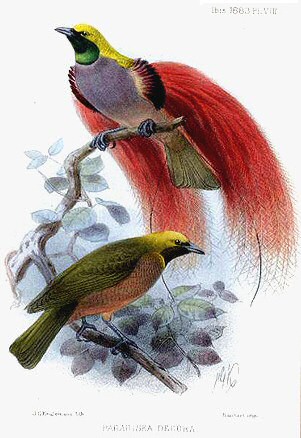
Sexual selection is a mode of natural selection in which members of one biological sex choose mates of the other sex to mate with, and compete with members of the same sex for access to members of the opposite sex. These two forms of selection mean that some individuals have greater reproductive success than others within a population, for example because they are more attractive or prefer more attractive partners to produce offspring. Successful males benefit from frequent mating and monopolizing access to one or more fertile females. Females can maximise the return on the energy they invest in reproduction by selecting and mating with the best males.

Fisherian runaway or runaway selection is a sexual selection mechanism proposed by the mathematical biologist Ronald Fisher in the early 20th century, to account for the evolution of ostentatious male ornamentation by persistent, directional female choice. An example is the colourful and elaborate peacock plumage compared to the relatively subdued peahen plumage; the costly ornaments, notably the bird's extremely long tail, appear to be incompatible with natural selection. Fisherian runaway can be postulated to include sexually dimorphic phenotypic traits such as behavior expressed by a particular sex.

The Descent of Man, and Selection in Relation to Sex is a book by English naturalist Charles Darwin, first published in 1871, which applies evolutionary theory to human evolution, and details his theory of sexual selection, a form of biological adaptation distinct from, yet interconnected with, natural selection. The book discusses many related issues, including evolutionary psychology, evolutionary ethics, evolutionary musicology, differences between human races, differences between sexes, the dominant role of women in mate choice, and the relevance of the evolutionary theory to society.
Sex differences in psychology are differences in the mental functions and behaviors of the sexes and are due to a complex interplay of biological, developmental, and cultural factors. Differences have been found in a variety of fields such as mental health, cognitive abilities, personality, emotion, sexuality, friendship, and tendency towards aggression. Such variation may be innate, learned, or both. Modern research attempts to distinguish between these causes and to analyze any ethical concerns raised. Since behavior is a result of interactions between nature and nurture, researchers are interested in investigating how biology and environment interact to produce such differences, although this is often not possible.

Parental investment, in evolutionary biology and evolutionary psychology, is any parental expenditure that benefits offspring. Parental investment may be performed by both males and females, females alone or males alone. Care can be provided at any stage of the offspring's life, from pre-natal to post-natal.
Between 1868 and 1872, the life and work of Charles Darwinfrom Descent of Man to Emotions continued with aspects of his intended "Big Book" on evolution through natural selection. He had by then hurriedly published an "abstract" of this work as On the Origin of Species in 1859, and following the immediate reaction to Darwin's theory his earlier work included demonstrating the utility of the flowers of Orchids in directing insect pollination to achieve cross fertilisation, and a summing up of thirteen years of experiments in The Variation of Animals and Plants Under Domestication which went on sale on 30 January 1868. He now published his ideas on human evolution and on how beautiful but apparently impractical features could have evolved in The Descent of Man, and Selection in Relation to Sex. After revising The Origin of Species as the definitive 6th edition, his major works on species culminated in The Expression of the Emotions in Man and Animals. This period was followed by extensive work on insectivorous plants and research into worms.
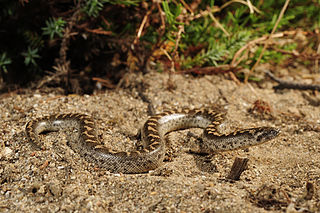
A psychological adaptation is a functional, cognitive or behavioral trait that benefits an organism in its environment. Psychological adaptations fall under the scope of evolved psychological mechanisms (EPMs), however, EPMs refer to a less restricted set. Psychological adaptations include only the functional traits that increase the fitness of an organism, while EPMs refer to any psychological mechanism that developed through the processes of evolution. These additional EPMs are the by-product traits of a species’ evolutionary development, as well as the vestigial traits that no longer benefit the species’ fitness. It can be difficult to tell whether a trait is vestigial or not, so some literature is more lenient and refers to vestigial traits as adaptations, even though they may no longer have adaptive functionality. For example, xenophobic attitudes and behaviors, some have claimed, appear to have certain EPM influences relating to disease aversion, however, in many environments these behaviors will have a detrimental effect on a person's fitness. The principles of psychological adaptation rely on Darwin's theory of evolution and are important to the fields of evolutionary psychology, biology, and cognitive science.

Mate choice is one of the primary mechanisms under which evolution can occur. It is characterized by a "selective response by animals to particular stimuli" which can be observed as behavior. In other words, before an animal engages with a potential mate, they first evaluate various aspects of that mate which are indicative of quality—such as the resources or phenotypes they have—and evaluate whether or not those particular trait(s) are somehow beneficial to them. The evaluation will then incur a response of some sort.
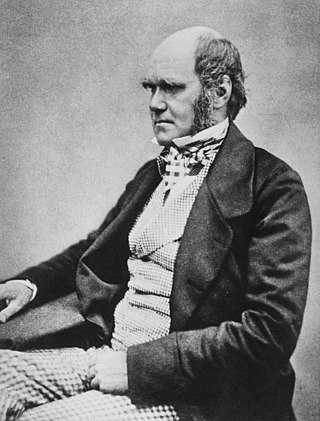
Charles Robert Darwin was an English naturalist, geologist and biologist, widely known for his contributions to evolutionary biology. His proposition that all species of life have descended from a common ancestor is now generally accepted and considered a fundamental concept in science. In a joint publication with Alfred Russel Wallace, he introduced his scientific theory that this branching pattern of evolution resulted from a process he called natural selection, in which the struggle for existence has a similar effect to the artificial selection involved in selective breeding. Darwin has been described as one of the most influential figures in human history and was honoured by burial in Westminster Abbey.
Barbara Creed is a professor of cinema studies in the School of Culture and Communication at the University of Melbourne. She is the author of six books on gender, feminist film theory, and the horror genre. Creed is a graduate of Monash and La Trobe universities where she completed doctoral research using the framework of psychoanalysis and feminist theory to examine horror films. She is known for her cultural criticism.
Fisher's principle is an evolutionary model that explains why the sex ratio of most species that produce offspring through sexual reproduction is approximately 1:1 between males and females. A. W. F. Edwards has remarked that it is "probably the most celebrated argument in evolutionary biology".

Sexual selection in humans concerns the concept of sexual selection, introduced by Charles Darwin as an element of his theory of natural selection, as it affects humans. Sexual selection is a biological way one sex chooses a mate for the best reproductive success. Most compete with others of the same sex for the best mate to contribute their genome for future generations. This has shaped human evolution for many years, but reasons why humans choose their mates are not fully understood. Sexual selection is quite different in non-human animals than humans as they feel more of the evolutionary pressures to reproduce and can easily reject a mate. The role of sexual selection in human evolution has not been firmly established although neoteny has been cited as being caused by human sexual selection. It has been suggested that sexual selection played a part in the evolution of the anatomically modern human brain, i.e. the structures responsible for social intelligence underwent positive selection as a sexual ornamentation to be used in courtship rather than for survival itself, and that it has developed in ways outlined by Ronald Fisher in the Fisherian runaway model. Fisher also stated that the development of sexual selection was "more favourable" in humans.
In sexual relationships, concepts of age disparity, including what defines an age disparity, have developed over time and vary among societies. Differences in age preferences for mates can stem from partner availability, gender roles, and evolutionary mating strategies, and age preferences in sexual partners may vary cross-culturally. There are also social theories for age differences in relationships as well as suggested reasons for 'alternative' age-hypogamous relationships. Age-disparate relationships have been documented for most of recorded history and have been regarded with a wide range of attitudes dependent on sociocultural norms and legal systems.
Patriarchy is a social system in which positions of dominance and privilege are held by men. The term patriarchy is used both in anthropology to describe a family or clan controlled by the father or eldest male or group of males, and in feminist theory to describe a broader social structure in which men as a group dominate women and children.
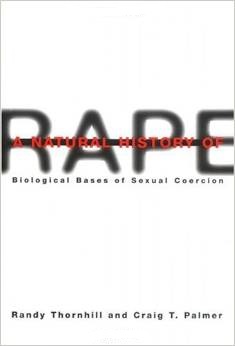
A Natural History of Rape: Biological Bases of Sexual Coercion is a 2000 book by the biologist Randy Thornhill and the anthropologist Craig T. Palmer, in which the authors argue that evolutionary psychology can account for rape among human beings, maintain that rape is either a behavioral adaptation or a byproduct of adaptive traits such as sexual desire and aggressiveness, and make proposals for preventing rape. They also criticize the assumption that there is a connection between what is naturally selected and what is morally right or wrong, which they refer to as the "naturalistic fallacy", and the idea, popularized by the feminist author Susan Brownmiller in Against Our Will (1975), that rape is an expression of male domination and is not sexually motivated.
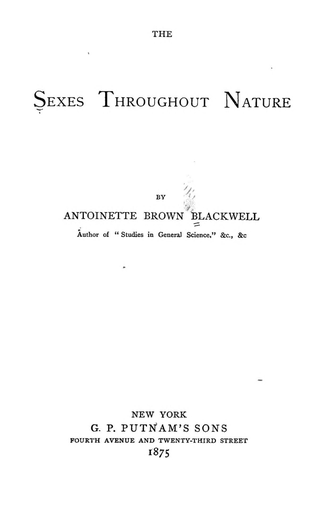
The Sexes Throughout Nature is a book written by Antoinette Brown Blackwell, published by G. P. Putnam's Sons in 1875.
Sexual division of labour (SDL) is the delegation of different tasks between the male and female members of a species. Among human hunter-gatherer societies, males and females are responsible for the acquisition of different types of foods and shared them with each other for a mutual or familial benefit. In some species, males and females eat slightly different foods, while in other species, males and females will routinely share food; but only in humans are these two attributes combined. The few remaining hunter-gatherer populations in the world serve as evolutionary models that can help explain the origin of the sexual division of labour. Many studies on the sexual division of labour have been conducted on hunter-gatherer populations, such as the Hadza, a hunter-gatherer population of Tanzania. In modern day society, sex differences in occupation is seen across cultures, with the tendency that men do technical work and women tend to do work related to care.
The theoretical foundations of evolutionary psychology are the general and specific scientific theories that explain the ultimate origins of psychological traits in terms of evolution. These theories originated with Charles Darwin's work, including his speculations about the evolutionary origins of social instincts in humans. Modern evolutionary psychology, however, is possible only because of advances in evolutionary theory in the 20th century.

T. W. Wood was an English zoological illustrator responsible for the accurate drawings in major nineteenth century works of natural history including Darwin's The Descent of Man and Wallace's The Malay Archipelago. He studied the courtship display behaviour of pheasants, observing them closely and publishing the first description of the double-banded argus pheasant. He illustrated many books, often of birds but also of moths and mammals.

The Evolution of Beauty: How Darwin's Forgotten Theory of Mate Choice Shapes the Animal World—and Us is a 2017 book by the ornithologist and evolutionary biologist Richard O. Prum about the power of aesthetic mate choice, arguing it to be an important independent agent in evolution. Prum indicates that while Charles Darwin made this argument in The Descent of Man, published in 1871, the concept was sidelined and forgotten and the notion of natural selection being the sole driver of evolution took over. As an ornithologist, Prum describes many examples in avian evolution where aesthetics are preeminent. Prum proceeds to apply the principle of aesthetic evolution as an independent force in human evolution.











